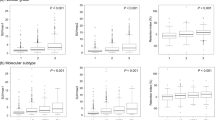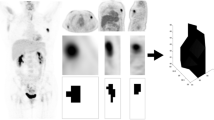Abstract
We prospectively investigated using advanced magnetic resonance imaging (MRI) and positron emission tomography/computed tomography (PET/CT) to identify radiological biomarkers for treatment response in patients receiving preoperative systemic therapy (PST) for locally advanced breast cancer. Patients with a stage II or III breast cancer receiving PST were selected and underwent positron emission tomography (PET), magnetic resonance imaging (MRI), and breast biopsies at baseline and after the first cycle of PST (days 7–8) during the full course of treatment. PET/CT was acquired after injection of 2-deoxy-2-[18F]-fluoro-d-glucose (18FDG, 0.22 mCi/kg) and quantified with standardized uptake value assessment (SUV). Diagnostic breast MRI and sodium (23Na) was acquired at 1.5 T. Total tissue sodium concentration (TSC), response criteria in solid tumors (RECIST), and volumes were quantified. Treatment response was determined by pathological assessment at surgery. Immunohistochemistry values of the proliferative index (Ki-67) were performed on biopsy specimens. Six of nineteen eligible women (43 ± 11 years) who received PST underwent radiological imaging of 18FDG-PET/CT and MRI for at least two cycles of treatment. Five patients had a pathological partial response (pPR) and one had pathological non-response (pNR). TSC decreased 21% in responders with increases in the non-responder (P = 0.03). Greater reduction in SUV was observed in responders (38%) compared to the non-responder (22%; P = 0.03). MRI volumes decreased after cycle 1 by 42% (responders) and 35% (non-responder; P = 0.11). Proliferation index Ki-67 declined in responders in the first cycle (median = 47%, range = 29–20%), but increased (4%) in the non-responder. Significant decreases in TSC, SUV, and Ki-67 were observed in responders with increases in TSC and Ki-67 in non-responders. Our results demonstrate the feasibility of using multi-modality proton, 23Na MRI, and PET/CT metrics as radiological biomarkers for monitoring response to PST in patients with operable breast cancer.




Similar content being viewed by others
References
Jemal A, Siegel R, Xu J, Ward E (2010) Cancer statistics, 2010. CA Cancer J Clin 60(5):277–300
Wolff AC, Berry D, Carey LA, Colleoni M, Dowsett M, Ellis M, Garber JE, Mankoff D, Paik S, Pusztai L et al (2008) Research issues affecting preoperative systemic therapy for operable breast cancer. J Clin Oncol 26(5):806–813
Lehman CD, Gatsonis C, Kuhl CK, Hendrick RE, Pisano ED, Hanna L, Peacock S, Smazal SF, Maki DD, Julian TB et al (2007) MRI evaluation of the contralateral breast in women with recently diagnosed breast cancer. N Engl J Med 356(13):1295–1303
El Khouli RH, Jacobs MA, Bluemke DA (2008) Magnetic resonance imaging of the breast. Semin Roentgenol 43(4):265–281
Partridge SC, Gibbs JE, Lu Y, Esserman LJ, Tripathy D, Wolverton DS, Rugo HS, Hwang ES, Ewing CA, Hylton NM (2005) MRI measurements of breast tumor volume predict response to neoadjuvant chemotherapy and recurrence-free survival. AJR Am J Roentgenol 184(6):1774–1781
Manton DJ, Chaturvedi A, Hubbard A, Lind MJ, Lowry M, Maraveyas A, Pickles MD, Tozer DJ, Turnbull LW (2006) Neoadjuvant chemotherapy in breast cancer: early response prediction with quantitative MR imaging and spectroscopy. Br J Cancer 94(3):427–435
Yu HJ, Chen JH, Mehta RS, Nalcioglu O, Su MY (2007) MRI measurements of tumor size and pharmacokinetic parameters as early predictors of response in breast cancer patients undergoing neoadjuvant anthracycline chemotherapy. J Magn Reson Imaging 26(3):615–623
Baek HM, Chen JH, Nie K, Yu HJ, Bahri S, Mehta RS, Nalcioglu O, Su MY (2009) Predicting pathologic response to neoadjuvant chemotherapy in breast cancer by using MR imaging and quantitative 1H MR spectroscopy. Radiology 251(3):653–662
Jacobs MA, Stearns V, Wolff AC, Barker PB, Tsangaris T, Argani P, Davidson NE, Bhujwalla ZM, Bluemke DA, Ouwerkerk R (2010) Multiparametric magnetic resonance imaging, spectroscopy and multinuclear (23Na) imaging monitoring of preoperative chemotherapy for locally advanced breast cancer. Acad Radiol 17(12):1477–1485
Wahl RL (1998) Positron emission tomography (PET): an update on applications in breast cancer. Breast Dis 10(3–4):165–175
Kim SJ, Kim SK, Lee ES, Ro J, Kang S (2004) Predictive value of [18F]FDG PET for pathological response of breast cancer to neo-adjuvant chemotherapy. Ann Oncol 15(9):1352–1357
Kelloff G, Hoffman JM, Johnson B, Scher HI, Siegel BA, Cheng EY, Cheson BD, O’Shaughnessy J, Guyton KZ, Mankoff DA et al (2005) Progress and promise of FDG-PET imaging for cancer patient management and oncologic drug development. Clin Cancer Res 11(8):2785–2808
Tatsumi M, Cohade C, Mourtzikos KA, Fishman EK, Wahl RL (2006) Initial experience with FDG-PET/CT in the evaluation of breast cancer. Eur J Nucl Med Mol Imaging 33(3):254–262
Chen X, Moore MO, Lehman CD, Mankoff DA, Lawton TJ, Peacock S, Schubert EK, Livingston RB (2004) Combined use of MRI and PET to monitor response and assess residual disease for locally advanced breast cancer treated with neoadjuvant chemotherapy. Acad Radiol 11(10):1115–1124
Iagaru A, Masamed R, Keesara S, Conti PS (2007) Breast MRI and 18F FDG PET/CT in the management of breast cancer. Ann Nucl Med 21(1):33–38
Berriolo-Riedinger A, Touzery C, Riedinger JM, Toubeau M, Coudert B, Arnould L, Boichot C, Cochet A, Fumoleau P, Brunotte F (2007) [18F]FDG-PET predicts complete pathological response of breast cancer to neoadjuvant chemotherapy. Eur J Nucl Med Mol Imaging 34(12):1915–1924
Wahl RL, Jacene H, Kasamon Y, Lodge MA (2009) From RECIST to PERCIST: evolving considerations for PET response criteria in solid tumors. J Nucl Med 50(suppl 1):122S–150S
Moy L, Ponzo F, Noz ME, Maguire GQ Jr, Murphy-Walcott AD, Deans AE, Kitazono MT, Travascio L, Kramer EL (2007) Improving specificity of breast MRI using prone PET and fused MRI and PET 3D volume datasets. J Nucl Med 48(4):528–537
Ouwerkerk R, Jacobs MA, Macura KJ, Wolff AC, Stearns V, Mezban SD, Khouri NF, Bluemke DA, Bottomley PA (2007) Elevated tissue sodium concentration in malignant breast lesions detected with non-invasive (23)Na MRI. Breast Cancer Res Treat 106(2):151–160
Boada FE, Gillen JS, Shen GX, Chang SY, Thulborn KR (1997) Fast three dimensional sodium imaging. Magn Reson Med 37(5):706–715
Jacobs MA, Knight RA, Windham JP, Zhang ZG, Soltanian-Zadeh H, Goussev AV, Peck DJ, Chopp M (1999) Identification of cerebral ischemic lesions in rat using eigenimage filtered magnetic resonance imaging. Brain Res 837(1–2):83–94
El Khouli RH, Macura KJ, Jacobs MA, Khalil T, Kamel I, Dwyer A, Bluemke DA (2009) Dynamic contrast enhanced magnetic resonance imaging of the breast: quantitative method for kinetic curve type assessment. Am J Roentgenol 196(4):W295–W300
Therasse P, Eisenhauer EA, Verweij J (2006) RECIST revisited: a review of validation studies on tumour assessment. Eur J Cancer 42(8):1031–1039
Eisenhauer EA, Therasse P, Bogaerts J, Schwartz LH, Sargent D, Ford R, Dancey J, Arbuck S, Gwyther S, Mooney M et al (2009) New response evaluation criteria in solid tumours: revised RECIST guideline (version 1.1). Eur J Cancer 45(2):228
Thie JA (2004) Understanding the standardized uptake value, its methods, and implications for usage. J Nucl Med 45(9):1431–1434
Kenny L, Coombes RC, Vigushin DM, Al-Nahhas A, Shousha S, Aboagye EO (2007) Imaging early changes in proliferation at 1 week post chemotherapy: a pilot study in breast cancer patients with 3′-deoxy-3′-[18F]fluorothymidine positron emission tomography. Eur J Nucl Med Mol Imaging 34(9):1339–1347
McDermott GM, Welch A, Staff RT, Gilbert FJ, Schweiger L, Semple SI, Smith TA, Hutcheon AW, Miller ID, Smith IC et al (2007) Monitoring primary breast cancer throughout chemotherapy using FDG-PET. Breast Cancer Res Treat 102(1):75–84
Jaffe CC (2008) Response assessment in clinical trials: implications for sarcoma clinical trial design. Oncologist 13(suppl 2):14–18
Van den Abbeele AD (2008) The lessons of GIST–PET and PET/CT: a new paradigm for imaging. Oncologist 13(suppl 2):8–13
Sharma U, Danishad KK, Seenu V, Jagannathan NR (2009) Longitudinal study of the assessment by MRI and diffusion-weighted imaging of tumor response in patients with locally advanced breast cancer undergoing neoadjuvant chemotherapy. NMR Biomed 22(1):104–113
Danishad KK, Sharma U, Sah RG, Seenu V, Parshad R, Jagannathan NR (2010) Assessment of therapeutic response of locally advanced breast cancer (LABC) patients undergoing neoadjuvant chemotherapy (NACT) monitored using sequential magnetic resonance spectroscopic imaging (MRSI). NMR Biomed 23(3):233–241
Ei Khouli RH, Jacobs MA, Mezban SD, Huang P, Kamel IR, Macura KJ, Bluemke DA (2010) Diffusion-weighted imaging improves the diagnostic accuracy of conventional 3.0-T breast MR imaging. Radiology 256(1):64–73
Avril N, Menzel M, Dose J, Schelling M, Weber W, Janicke F, Nathrath W, Schwaiger M (2001) Glucose metabolism of breast cancer assessed by 18F-FDG PET: histologic and immunohistochemical tissue analysis. J Nucl Med 42(1):9–16
MacGrogan G, Mauriac L, Durand M, Bonichon F, Trojani M, de Mascarel I, Coindre JM (1996) Primary chemotherapy in breast invasive carcinoma: predictive value of the immunohistochemical detection of hormonal receptors, p53, c-erbB-2, MiB1, pS2 and GST pi. Br J Cancer 74(9):1458–1465
Ouwerkerk R, Bottomley PA, Solaiyappan M, Spooner AE, Tomaselli GF, Wu KC, Weiss RG (2008) Tissue sodium concentration in myocardial infarction in humans: a quantitative 23Na MR imaging study. Radiology 248(1):88–96
Jacobs MA, Ouwerkerk R, Kamel I, Bottomley PA, Bluemke DA, Kim HS (2009) Proton, diffusion-weighted imaging, and sodium ((23)Na) MRI of uterine leiomyomata after MR-guided high-intensity focused ultrasound: a preliminary study. J Magn Reson Imaging 29(3):649–656
Mellon EA, Pilkinton DT, Clark CM, Elliott MA, Witschey WR 2nd, Borthakur A, Reddy R (2009) Sodium MR imaging detection of mild Alzheimer disease: preliminary study. AJNR Am J Neuroradiol 30(5):978–984
Acknowledgments
We thank all the patients for participating in these studies. We are grateful for the help of Mary McAllister, MA., Lucie Bower, Dr. Donald Peck, and Dr. Hamid Soltanian-Zadeh, Henry Ford Hospital, Detroit, MI for the Eigentool image analysis software used for image processing. Part of this work was funded in part by the National Institute of Health Grants: R01CA100184, P50CA103175, Breast Specialized Program of Research Excellence P50CA88843, 5P30CA006973, U01CA070095, U01CA140204, Avon:01-2009-031, and Damon Runyon-Lilly Clinical Investigator Award CI-3 from the Damon Runyon Cancer Research Foundation.
Author information
Authors and Affiliations
Corresponding author
Rights and permissions
About this article
Cite this article
Jacobs, M.A., Ouwerkerk, R., Wolff, A.C. et al. Monitoring of neoadjuvant chemotherapy using multiparametric, 23Na sodium MR, and multimodality (PET/CT/MRI) imaging in locally advanced breast cancer. Breast Cancer Res Treat 128, 119–126 (2011). https://doi.org/10.1007/s10549-011-1442-1
Received:
Accepted:
Published:
Issue Date:
DOI: https://doi.org/10.1007/s10549-011-1442-1




